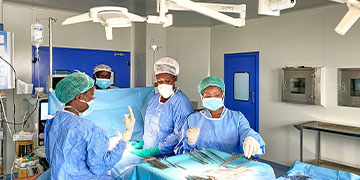We're here to help
Talk to an expert today.
Our friendly team of highly trained specialists will quickly assist you.
Technical Expertise
- With over 35 years of in-house development of proprietary electronics hardware, firmware, embedded software and enclosure technology along with in-house knowledge, IntelliPower has the ability to respond quickly to all requests.
- Their modular design approach facilitates the addition of features and specifications as needed to a library of existing product configurations that have already been sold, tested and proven reliable in the field.
- Functional drop-in replacements for competitor's products (easy for customers to make significant solution improvements).
- Designed to meet MIL STD 461, 1399, 810, 901 and others - a requirement that often disqualifies competitors.
- An in-house EMI test lab and professional shielded screen room streamlines verification and compliance.
External Battery Modules for Extreme Conditions
AMETEK IntelliPower are the leading manufacturer of Rugged UPS for extreme conditions, high temperatures, military and mission critical applications. In these situations, if power supply is interrupted, the consequences may be devastating from a community safety, financial, functional or strategic perspective. Infrastructure such as traffic lights, ramp meters, flood & extreme weather warning systems, toll ways, etc – all of these functions need highly reliable continuity of power supply. In addition, the need for this equipment to be able to operate in extreme conditions demands the highest possible quality.
IntelliPower manufacture an extensive range of External Battery Modules that cater for many different specifications and feature sets. There are many choices for voltage, string configurations, Hot swap options, chassis configurations and connector types. They incorporate state-of-the-art Lithium Iron Phosphate (LiFePO4) battery technology (10x longer cycle life than its lead acid equivalent).
AMETEK IntelliPower products have been field-proven with superior performance and safety in extreme temperatures and extreme outdoor environments with challenging shock and vibration applications. They utilise online double-conversion technology which isolates equipment from raw utility power or generators and produces a regulated pure sine wave output that protects sensitive electronics from every power anomaly imaginable.
Who is IntelliPower?
Located in Orange, California and part of the Ametek group, IntelliPower has been designing and manufacturing UPS and power conversion solutions to protect mission-critical applications since 1988. Their products utilise digitally controlled, high-efficiency power switching technology that has been field tested for over 35 years on numerous platforms. Considered the global reference for military and demanding environment applications, Intellipower’s expertise, experience and proven track record is unsurpassed. Their in-house proprietary circuit design, DSP firmware/software technology and wide range of enclosure designs give them unmatched capabilities to deliver systems configured to custom customer requirements, comply to tough military and ISO standards & backed by expert support.

IntelliPower’s Clients
IntelliPower design, manufacture and support an extensive range of Rugged UPS Power Protection Solutions serving a wide range of defence and industrial applications around the globe. It partners with major infrastructure, intelligent transportation, oil/gas/mining exploration and military companies, all who require mission critical reliable continuous power supply in challenging environments. Military applications are perhaps the most challenging and compliance to stringent military standards ensures that IntelliPower is at the forefront of UPS technology and innovation.

Defence
lntelliPower is the largest and most successful supplier of high reliability, rugged UPS for the military. Military operations demand increased durability, performance & reliability of their UPS due to the extreme terrains & climates in which they must seamlessly perform. Rugged UPS are critical during extended military operations by preventing data loss, maintaining battery charge, providing continuous power & surge protection. Military UPS must also meet high military standards/specifications to ensure quality of performance - MIL-STD-704E (aircraft), MIL-STD-1275D (ground), MIL-STD-1399-300B (shipboard), MIL-STD-810G (environmental test methods), and MIL-STD-461F (EMI). Meticulous design and construction enable higher efficiency, smaller size, lower weight, and the challenges of multi-voltage electronics.

Infrastructure
ITS technologies such as traffic lights, CCTV cameras, vehicle detection systems, digital traffic signs, flood warning systems, electronic toll collection, ramp meters, red light cameras, etc. all need rugged back-up power supply for continuity of supply. Power disruptions to infrastructure and transportation systems can have adverse effects on a society’s ability to function. AMETEK IntelliPower UPS systems utilise online double-conversion technology which isolates equipment from raw utility power or generators and produces a regulated pure sine wave output that protects sensitive electronics from every power anomaly imaginable. Designed for extreme outdoor environments, IntelliPower’s Rugged UPS solutions are the backbone of critical infrastructure.

Oil and Gas
When it comes to mission-critical and safety-critical applications in hostile environments like oil and gas production facilities where the loss of power can easily result in millions of dollars of lost production and may potentially involve injury and loss of life, failure is simply not an option. IntelliPower has decades of experience creating UPS systems for use in the Oil and Gas industry, from upstream (exploration and production of crude oil and natural gas) to midstream (transportation and storage, including pipelines, pumping stations, tank trucks & transcontinental tankers) to downstream (refining crude oil into fuels such as gasoline, kerosene, heating oils, jet fuels, etc & also transforming crude oil and natural gas into plastics, synthetic rubbers, fertilizers, preservatives, etc).


Highest Efficiency
IntelliPower utilise a high frequency transformer-less design, giving the highest efficiency possible. This reduces internal heat and secondary cooling requirements.

Pure Sinewave Output
The Online Double Conversion UPS provides a clean pure sinewave with accurate voltage and frequency regulation. Ideal for sensitive loads.

Immunity from Supply Disturbances
The IntelliPower Double Conversion UPS isolates the protected load from poor input power.

Improved Power Factor
An IntelliPower UPS increases Power Factor as high as 0.99, dramatically lowering input power requirements.
We're here to help
Talk to an expert today.
Our friendly team of highly trained specialists will quickly assist you.
We promise to respond within 4 business hours (AEST).
Or you will receive $100 off your next purchase. Read how it works.
Applicable Industries
Top FAQs
Yes, a Continuum UPS will extend the service life of critical components whilst retaining work or process efficiency.
Yes , many models have modular batteries or modular power modules allowing your UPS to grow with you and your business.
When compared to older UPS types, a Continuum UPS is among the highest efficiency UPS products incorporating power saving features and best of class circuit design.
There are several factors that influence sizing a UPS system, including the combined load of all the equipment the UPS will protect, scope for further system expansion, battery runtime and redundancy.
As well as choosing the right UPS topology, correctly sizing an uninterruptible power supply is crucial. Under-sizing inevitably causes immediate problems, while initial oversizing will waste energy, money and valuable floor space.
The easiest way to ensure a correctly sized UPS system is to get prospective suppliers to undertake a full site survey where they can accurately assess your requirements. However, it is possible to broadly size a UPS yourself by following a step-by-step process.
Critical or Non-Critical Loads
This starts with listing and reviewing all the equipment that will need to be protected by the UPS. Establish whether an item of equipment is critical – and therefore will need the emergency backup provided by the UPS – or non-critical, which can be allowed to fail when the mains power supply does so.
Power Range
The next step is to calculate the total power range for the combined critical load that needs protecting. It’s important to base this on use during peak working hours, rather than on quieter times such as an office network during the night. Equipment labels and supporting technical data will provide information such as the supply voltage, frequency, number of phases, load current, power factor and power consumption. The power consumption of electrical equipment is stated in either Watts (W) or Volt-Amperes (VA). Because UPS systems are rated by VA or kVA ratings, this may require a conversion from W to VA, which can be calculated by dividing the power consumption (W) by the power factor. Add up all the VA, then multiply this by a figure such as 1.2 or 1.25, which factors in future growth and system expansion. That figure is the maximum size in VA or kVA that your UPS should be. Note that a UPS should never be sized to run at 100% load capacity, as this isn’t recommended for safe, stable and reliable performance.
Potentially Problematic Loads
Certain equipment (i.e. laser printers, blade servers, air conditioners, certain lighting systems, motors and compressors) have an in-rush of current during start-up or draw higher currents in normal operation, which can cause the UPS to overload. This can lead to intermittent alarms or potentially send the UPS into bypass mode. For these types of load, good practice suggests two options: either remove them from the power protection system (if the equipment can safely power down on mains failure) or oversize the UPS by a factor of at least three.
Battery Runtime
This is the amount of time you want the UPS to keep equipment operating in the event of a power failure. How to size a UPS battery depends on the nature of the equipment. In some circumstances, runtime only needs to be for a few minutes as a bridge to let the standby generators kick-in and take over.
The battery duration at a specified load level is referred to as the battery ‘autonomy’. A UPS battery can be sized to support loads from a few minutes up to several hours, however the cost of a large battery at a high load level can sometimes mean that a diesel generator should be considered. Increasing the ‘autonomy’ is achieved by adding extra battery strings connected in parallel, however it is important that the charging capability of the UPS system is considered.
Uninterruptible power supplies operating in parallel refers to when the outputs of two or more UPS are connected to supply the load via a common AC busbar.
There are two main configurations:
- Parallel-Capacity (N) where the total load demand is met by a number of UPS without the provision of any redundancy.
- Parallel-Redundant (N+X) where the total load demand is met by all the UPS sharing the load between themselves equally. If one of the UPS fails, the remainder are able to continue supporting the load.
‘N’ configuration solutions do not increase system resilience because they lack redundancy - they simply enable increased overall capacity by connecting multiple UPS to work together. The total capacity is calculated by the number of UPS modules used (also known as a Total Power System).
Because of the lack of redundancy, carrying out maintenance on a parallel-capacity installation means bypassing the entire UPS system so that one or more modules can be powered down for service. During UPS maintenance, the load is powered directly by the mains supply, so it is unprotected to any interruptions.
‘N+X’ configuration solutions are commonly used to protect mission-critical applications in data centres, industrial sites and larger business operations. The main principle behind a parallel-redundant UPS system is that it can continue to support the critical load should one or more UPS modules fail. Compared to N capacity installations, this means it can achieve higher availability and MTBF (mean time between failure).
In addition, this also enables UPS maintenance to take place without interrupting the load. Modules can be powered down for servicing while the remaining UPS continue supporting the load.
During normal operation, each UPS shares the load equally. Similarly, when the UPS system needs to run on batteries, each UPS will still share the load as each module has its own battery set, rather than a shared common battery.
If any of the UPS modules in a parallel-redundant configuration fails or experiences an internal fault, it automatically disconnects from the output AC busbar, while the remaining active UPS continue sharing the load.
In addition to parallel-capacity and parallel-redundant, there are other configurations to consider:
Isolated-Redundant: this is sometimes known as N+1 but it differs considerably to a parallel-redundant N+1 installation. In this configuration, there’s a main UPS module that feeds the load, while the secondary UPS feeds its static bypass. When a fault causes the primary UPS to transfer to bypass, the secondary module accepts the full load.
Distributed-Redundant: also known as Tri-Redundant and typically used in large multi-megawatt data centres. Made up of three or more UPS with independent input and output feeders, with the output buses connected to the load by several PDUs (and in certain cases Static Transfer Switches). This configuration does minimise single points of failure and offers the opportunity for concurrent maintenance, but it also leads to significant load management challenges.
Power factor (pf) is the difference between actual energy consumed (Watts) and the apparent power (Volts multiplied by Amps) in an AC circuit. It is calculated as a decimal or percentage between 0-1 pf and 0-100% i.e. 0.9 pF = 90%. The nearer the power factor is to unity (1 pf), the closer the two waveforms are in phase with each other and the device uses power more efficiently, hence why power factor relates to UPS efficiency.
Convention stipulates that inductive loads are defined as positive reactive power, with capacitive loads defined as negative reactive power. But power factor is never described as positive or negative, it is either lagging or leading.
Lagging Power Factor
These are loads where the current waveform lags behind the voltage by a factor equal to the load’s reactance, typically between 0.5 and 0.95.
Unity Power Factor
Unity power factor (1 pf) loads have the current and voltage waveforms in phase with each other. In the example below, a 2300 VA load with 1 pf has a real power value of 2300 W (2.3 kW).
Leading Power Factor
Loads with a leading power factor have a current waveform that leads the voltage by a factor equal to the load’s reactance, usually between 0.8 and 0.95. Using the same 2300 VA as in previous examples, a leading power factor of 0.766 has a real power value of 1762 W (1.76 kW).
Traditionally, UPS systems were designed to support loads with unity or lagging power factors.
However, modern uninterruptible power supplies can also now handle leading power factors. It does require careful planning during installation though, as leading power factors can place an overload on the UPS that it may not recognise.
Blade servers are the best example of a load with a leading power factor. They are capable of greater processing power within less rack space than traditional file servers and have been widely adopted in the telecoms and data centre sectors because of advantages such as simplified cabling and reduced power consumption.
There are several ways to try and reduce the impact of leading power factors, including increasing the size of the UPS, but the most common approach is to use active harmonic filters with power factor correction on the output.
This delivers a more acceptable load to the UPS, but it does reduce efficiency, take up more floor space and increase capital costs.
Related Resources

My client purchased four robots to milk cows 24/7. At the start of the project, I asked the OEM - “How quickly will the robots reboot/reset after an outage? You should know that we get outages all the time and that we get voltage swings with all the PV”. OEM - No answer. It was then decided to install two 10kVA UPS systems to fill the gap between an outage and the backup diesel generator supporting the customer’s load. Fuseco, a specialist in this area, were a great help in producing a solution for the split phase 480VAC system.
Peter Bulle
Director at CoGen Plus

Dealing with your team has been a very positive experience. The Continuum UPS solutions in conjunction with your professional advice solved our Demand Load Management challenges perfectly.
Frank Leonis
Project Engineer at SMEC

Reliable continuity of supply has been an issue for this project from its inception. The Continuum solutions implemented here have solved this issue and have given us peace of mind. Thank you guys for your patience, expertise and support.
Lawrence Cheng
Engineering Manager at ARUP
Technical Support
Our experts are all pre-eminent leaders in electrical products who provide excellent support in their areas of expertise.
Technical supportTalk to an expert
Our friendly team are highly trained product experts who really enjoy helping customers find what they need.
call 1300 387 326Enquire by email
We promise to respond within 4 business hours (AEST) or you will receive $100 off your next purchase.
Enquire now







